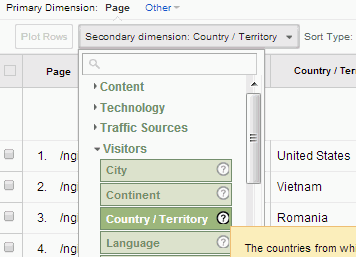Optimize Your Coverage with Secondary Dimension in Google Analytics
Wiki Article
Enhance Your Information Analysis Using Secondary Measurement in Google Analytics
Discovering the capabilities of secondary measurements in Google Analytics opens a realm of opportunities for refining data analysis. By layering added dimensions onto key data sets, a more detailed narrative emerges, losing light on individual interactions and efficiency signs.Recognizing Secondary Measurements
In the world of data evaluation, a critical aspect to understanding is the principle of secondary dimensions and their relevance in drawing out much deeper insights from Google Analytics reports. Secondary measurements in Google Analytics refer to additional parameters that can be contributed to the primary dimension, enabling a more detailed evaluation of data. By incorporating second dimensions, analysts can segment and filter data to uncover patterns, patterns, and connections that may not be evident when looking at the information all at once. These second measurements can supply context and a much more thorough understanding of user behavior, web traffic resources, and various other essential metrics tracked by Google Analytics.
Advantages of Using Second Dimensions
When analyzing information in Google Analytics, the usage of second dimensions supplies indispensable insights into customer behavior and efficiency metrics. By adding a secondary measurement to your main information, you can dive deeper into the attributes of your website visitors and their interactions.
In addition, second measurements improve the context of your key information, offering a much more comprehensive view of user interaction and performance metrics. Generally, the use of secondary measurements in Google Analytics can dramatically improve the deepness and high quality of your data analysis, leading to more informed decision-making and improved outcomes.
How to Include Secondary Measurements
By integrating second dimensions in Google Analytics, individuals can gain deeper understandings into their data analysis procedure, permitting for more thorough assessment of customer behavior and efficiency metrics. Including second dimensions is a straightforward procedure that can significantly enhance the depth of evaluation. As soon as in the record, locate the "Second measurement" tab above the information table.Analyzing Data With Secondary Measurements
Utilizing secondary dimensions in information evaluation gives a more detailed understanding of customer habits and efficiency metrics. By adding an additional dimension to your main information embeded in Google Analytics, you can dig deeper right into the characteristics of your website site visitors and their interactions. Integrating the primary measurement of 'source/medium' with the secondary measurement of 'landing web page' can reveal which details pages are attracting web traffic from various sources, helping you maximize these web pages for much better interaction.
Basically, analyzing information with additional dimensions encourages you to get important insights into individual behavior, recognize patterns, and make informed choices to enhance the efficiency of your electronic buildings.
Ideal Practices for Second Dimensions
In information analysis, incorporating second dimensions properly can considerably boost the depth of understandings stemmed from metrics and individual behavior patterns. When making use of secondary dimensions in Google Analytics or any type of various other logical device, it is vital to comply with ideal practices to make certain the accuracy and importance of the information analysis.One key best practice is to thoroughly pick additional measurements that match the main measurement being examined. Choosing second dimensions that provide extra context or further segmentation can provide an extra extensive understanding of the information. It is also essential to avoid overcomplicating the analysis by including a lot of secondary dimensions, which may bring about complication or dilution of understandings.
Moreover, it is a good idea to try out various combinations of main and second dimensions to uncover brand-new relationships and fads. On a regular basis evaluating and fine-tuning the choice of secondary dimensions based upon the specific goals of Learn More Here the analysis can cause even more actionable understandings. By adhering to these finest techniques, information experts can leverage second dimensions effectively to enhance the overall data analysis process and decision-making capacities.

Final Thought
To conclude, including second measurements in Google Analytics is necessary for a comprehensive data evaluation approach. By leveraging secondary measurements alongside main ones, experts and marketing experts can discover useful understandings and relationships that can notify decision-making and enhance digital advertising and marketing strategies. Comprehending exactly how to successfully make use of second measurements and adhering to ideal practices will allow specialists to remove significant data and enhance their total efficiency metrics.Second dimensions in Google Analytics refer to extra criteria that can be included to the primary measurement, enabling for an extra in-depth analysis of data. By including second measurements, analysts can section and filter information to reveal patterns, patterns, and connections that might not be noticeable when looking at the article source data as a whole. Combining the main dimension of 'source/medium' with the second dimension of 'touchdown web page' can expose which details web pages are bring in web traffic from different sources, helping you enhance these web pages for better engagement.
One key finest technique is to meticulously choose additional measurements that match the primary dimension being evaluated. By adhering to these finest practices, information experts can leverage secondary dimensions efficiently to boost the general information analysis procedure and decision-making capabilities.
Report this wiki page